The latest set of images from the long range imager, LORRI, on New Horizons now reveals surface features. At a press conference today, exhilarated NASA scientists discussed what the images are now suggesting. (Photo Credit: NASA/New Horizons)
Today, a trio of NASA scientists expressed their exhilaration with the set of new Pluto images released by the New Horizons team. “Land Ho” exclaimed Dr. Alan Stern as he first tried to explain where they are on their long journey. Nearly 500 years ago, not even Magellan on a three year journey to circumnavigate the Earth waited so long. A ten year journey is beginning to reveal fascinating new details of the dwarf planet Pluto, once the ninth planet of our Solar System. The latest images show surface features on Pluto suggesting polar caps.
A team effort that Dr. Weaver said called upon leading experts to resolve these newest details of Pluto’s surface. The inset at left shows schematically the geographic relationship of the two bodies as they orbit each other. The inset at right shows surface details at 3x maximum resolution. (Photo Credit: NASA/New Horizons)
The NASA press conference took place this afternoon, anchored by Dr. John Grunsfeld, Associate Administrator for the Science Mission Directorate who quickly turned over the discussion to the project scientist of the New Horizons mission, Dr. Alan Stern from the Southwest Research Institute of San Antonio, Texas. Grunsfeld began by stating NASA’s mission – “to explore, discover and inspire” and added that New Horizons is certainly executing these prime objectives.
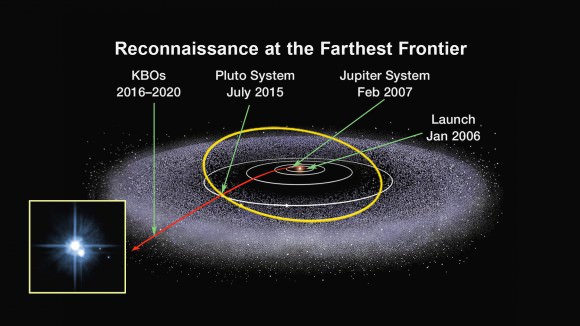
Alan Stern started off by expressing his excitement with the latest results from the long range telescope on board New Horizons, LORRI, but emphasized he represents a team effort, the culmination of decades of work.
With just 11 weeks remaining and now 98% of the way to Pluto, the latest set of images from LORRI have now revealed details better than the best that was previously attainable – from the Hubble Space Telescope. Most incredible are indications of polar caps on the dwarf planet Pluto.
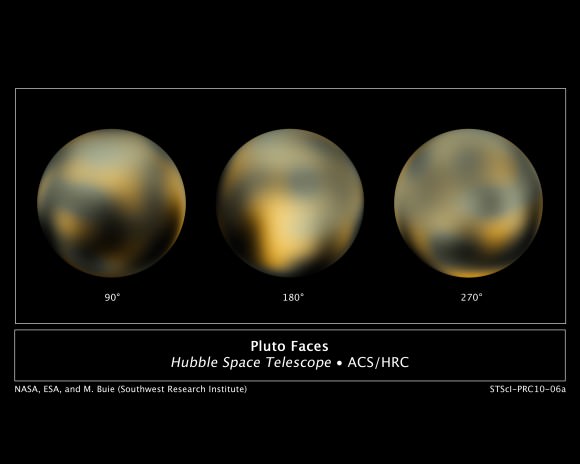
Dr. Stern, stated that the 25th Anniversay of the Hubble mission has also functioned as a segue to what is about to unfold from New Horizons. Until now, the best images of Pluto’s surface had been wrestled out of images from Hubble with computer processing. Yet, at the present distance New Horizons remains, his team is still relying on image processing to reveal these first surface details.
 The gravitational tug of war of the unique binary system has forced both small bodies to forever face each other, similar to how our Moon always faces the Earth. (Photo Credit: NASA/New Horizons)
The gravitational tug of war of the unique binary system has forced both small bodies to forever face each other, similar to how our Moon always faces the Earth. (Photo Credit: NASA/New Horizons)
Dr. Stern stated how remarkable the Pluto-Charon system is. The earlier set of LORRI images from 2014 had shown the gravitational dance of the two small bodies. He stated that they are truly a binary system and a type we have never explored before. Pluto-Charon is a dual synchronous, tidally locked system. Dr. Stern explained that the Earth, close-in to the Sun, and their space probe New Horizons, now on its final approach, is viewing the sunlit side of Pluto and Charon.
The system is tipped over relative to its orbital plane around the Sun. Dr. Stern stated, “it is like watching Pluto rotate on a spit.” He said that we are nearly seeing it face on; similar to an observer hovering far above the Earth’s polar cap and looking down upon the Earth-Moon system. The orbits of the two bodies, as seen in the LORRI image sequence (animations, above), appear elliptical (oval), however, due to the extreme and final state of this binary system, the orbits are perfect circles; the eccentricities are zero! New Horizons is just approaching slightly off center.
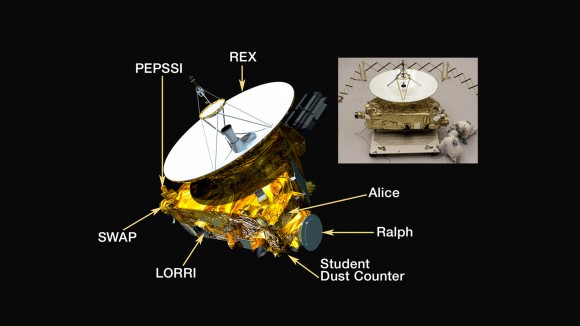
Dr. Stern continued and explained how this latest set is now showing surface features on Pluto. The features “are suggesting the presence of polar caps”, however he also emphasized that it remains only suggestive until New Horizons can deliver more details, that is, higher resolution, color imagery from the Ralph imager and spectroscopic data (Ralph and Alice imaging spectrometers) to reveal composition. Dr. Stern turned over the press conference to Dr. Hal Weaver of John Hopkins’ Applied Physics Laboratory, the lead scientist for the LORRI instrument.
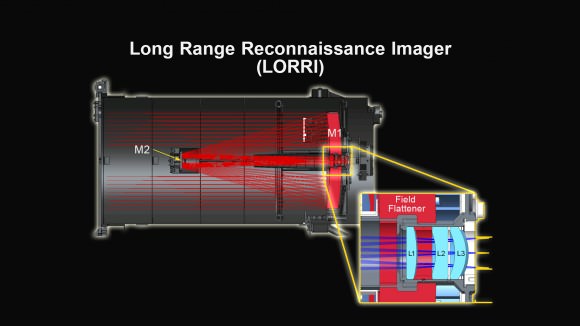
LORRI as Dr. Weaver explained is a state-of-the-art instrument. A fixed focus telescopic camera, functional from room temp down to 180 degees Fahrenheit below zero and utilizes an 8 inch primary mirror. The optical quality is extraordinary but the light gathering power is the same as one has in an amateur 8 inch telescope such as offered by Meade or Celestron. Still further, Dr. Weaver stated that LORRI is also extremely efficient and ligthweight, using less than 5 watts of power and weighing less than 20 lbs.
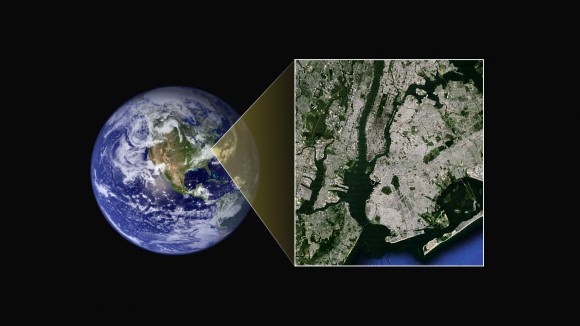
Dr. Weaver explained how the raw images from LORRI are presently little more than blotches of light, unspectacular at first glance, but with image processing, the details discussed today are revealed. The New Horizons team employed world-class experts in the technique of Image Deconvolution. It was again Hubble that spawned “a cottage industry”, over 20 years ago, including one expert – Todd Lauer of the National Optical Astronomy Observatory. Lauer and others took on the challenge of extracting quality imagery from the Hubble space telescope as it struggled with the astigmatism accidentally built into its optical system. A NASA Space Shuttle mission delivered and inserted a corrective lens into Hubble which has made its 25 years of service possible.
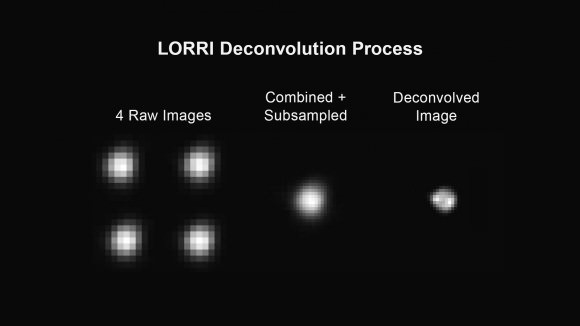
And the New Horizons’ processed images are now slightly better than Hubble and will just get much better. From the Q&A with the press. Weaver explained that while the images show more detail, Earth-based and Hubble images remain more light sensitive. Hubble sets an upper limit to the size of any remaining moons to be discovered. Weaver stated that by June, New Horizons’ LORRI will exceed the light sensitivity limits of Hubble. If there are more moons to be found, June will be the month.
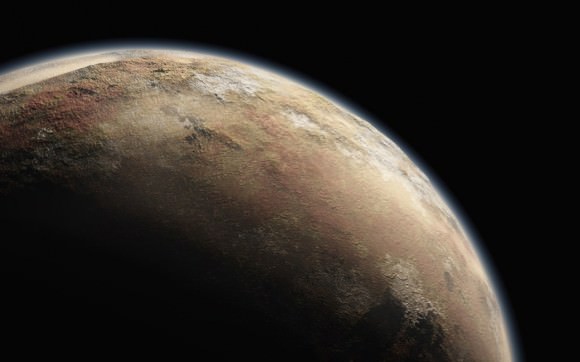
Through the Q&A, Dr. Stern stated that an extraordinary aspect of Pluto’s atmosphere is that the planet’s atmosphere has continued to expand despite having passed a point in its orbit at which it should be freezing and condensing onto its surface. The atmosphere expanded 200 to 300% in the last decade. With the limited observations, Stern and other Pluto experts surmise that there is a lag in the climate akin to how our hottest months lag the beginning of Summer by a couple of months. Perhaps, a latent heat stored up in the near surface has continued to vaporize frozen gases thus building up the atmosphere more than first expected.
The composition of the dwarf planet’s surface was discussed. Most evident in Earth-based spectroscopy is that there is molecular nitrogen, carbon monoxide and methane. Stern stated they these species of molecules could explain the bright and dark spots of the surface. However, he emphasized that Pluto is composed of 70% rock by mass and the remaining is ice. Charon stands in remarkable contrast to Pluto. Chraon has primarily water and ammonia hydrates on its surface; no detectable atmosphere (so far). Charon’s appearance is much more uniform and bland. Altogether, Stern said that experts call this the Pluto-Charon dichotomy.
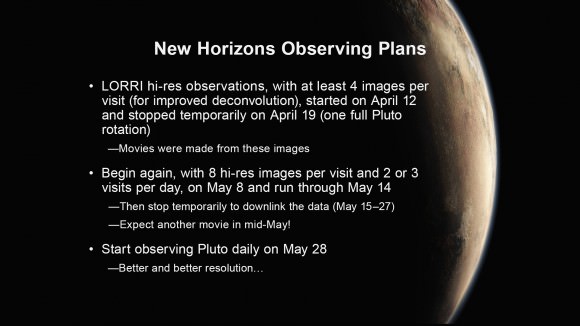
Dr. Stern near the end of the press conference restated that this is truly “my meet Pluto moment.” New Horizons is like a plane on its final approach to touchdown but New Horizons cannot slow down. There are no retro-rockets, no propulsion onboard that can slow down the probe on its trek to escape the gravity of the Sun. The probe will join the Pioneer and Voyager space probes as the only Human-made objects to leave the Solar System. With its final approach, with every day, Pluto and Charon closes in as Dr. Stern and Dr. Weaver explained, Pluto’s image will fill the full breadth of the imaging detector. Details on its surface will be equivalent to high resolution images of New York’s Manhattan (figure, above) showing details such as the ponds in Central Park.
To continue following the latest release of images from New Horizons go to http://www.nasa.gov/newhorizons/lorri-gallery.

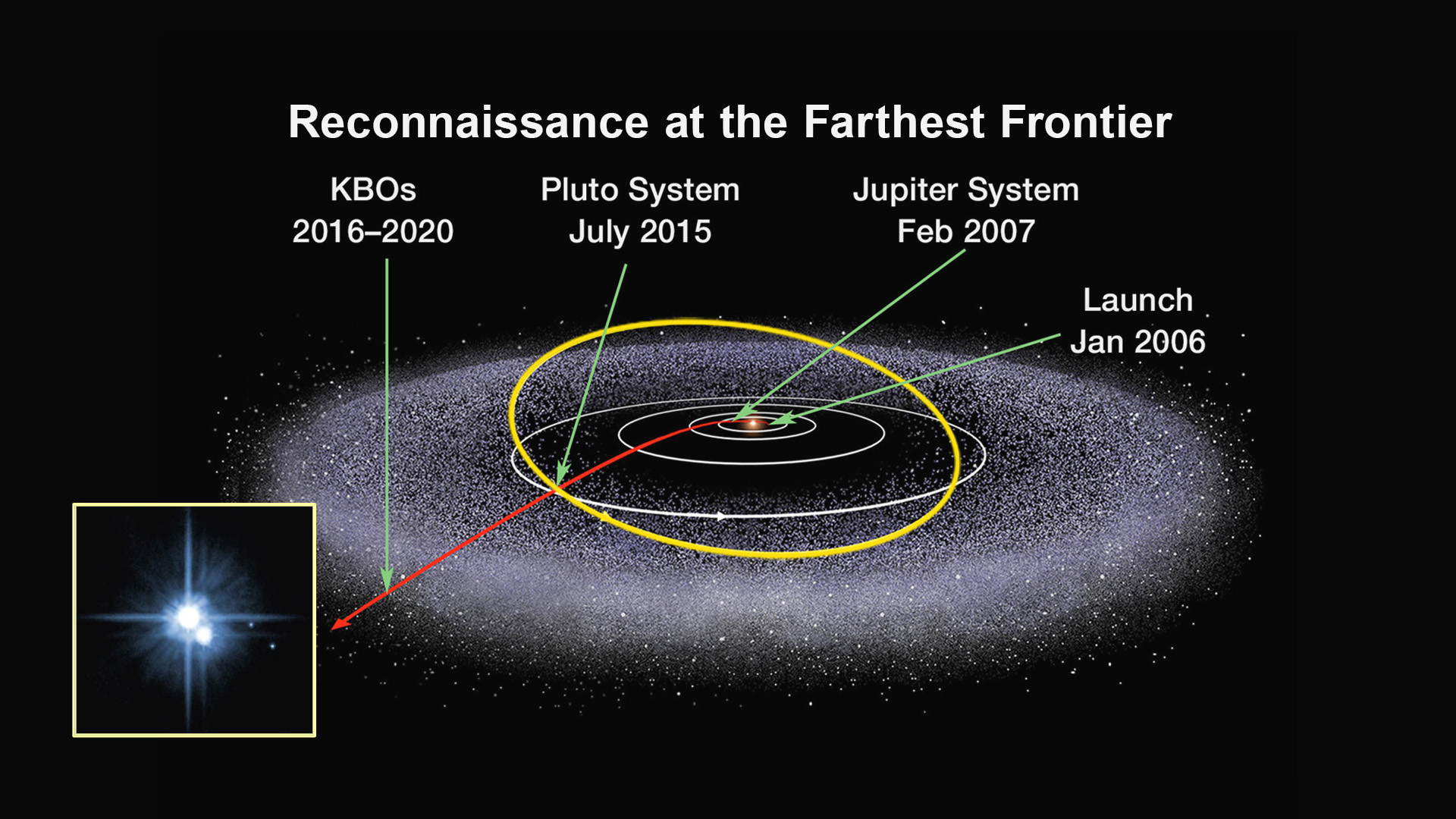
That’s great. How do we watch the press conference?
I can’t find it either. I’ve heard there’s a law which forces NASA to text and translate everything they archive, with the good intention of increasing availability. So they generally choose NOT to archive anything and spend that money and effort on space exploration instead, with zero availability as a result. But someone online usually stores the NASA clips and puts them up on Youtube within a few days.
The Press Conference was audio only and they offer that afterwards only through a phone call audio primarily for press to review statements.
This is possibly the most exciting experiment that we have made. Just can’t wait to see the images of this Planet, er, big rock in space,
It’s a planet. The images we get over the next few months will make that clear.
Great article except for one point: It is disappointing to see you go along with the controversial IAU decision by referring to Pluto as “once the ninth planet in our solar system.” Pluto is still a planet in our solar system according to many planetary scientists, starting with Alan Stern. He and they adhere to a geophysical planet definition, according to which a planet is any non-self-luminous spheroidal body orbiting a star. According to that definition, Pluto is the solar system’s tenth rather than ninth planet because Ceres, being spherical, is a small planet too. Would you consider at least using neutral language as opposed to writing under the assumption that one side in this debate somehow represents truth?
does it matter?
vooose, the whole point is that it doesn’t matter! Why did the IAU even raise this question, made a failed attempt of criteria to define a planet and vote about it? It’s like a circus where the clowns vote to define what a joke is. And conclude that a hot Jupiter is a dwarf planet.
At that IAU meeting, someone asked: “-What is a planet, really?” And the chairman got nervous when he realized that astronomers don’t know what a planet is. “-Ehm, let’s make up some definition and vote on it. How hard can it be, we know it when we see it. Quickly, before the media hears about this, we need a definition in order to avoid controversy and scandal…” And since then IAU youtube channel is all about titles like: “What is a planet?” “What is a dwarf planet?” “Why is Pluto not a planet?”
Voose makes a good point: Does it matter? Pluto will still be there as it always has been, no matter what we judge it, with all our intents – both wise and foolish. Just reprogram a neuron or two, and all of the (non-)controversy will evaporate away. Worked for me!
—
Reminds me of one of Robert Frosts short poems titled:
The Secret Sits
“We dance round in a ring and suppose,
But the Secret sits in the middle and knows.”
— “Does it matter”
Yes it does matter.
“Planet’ is shorter that calling it “The dwarf planet formerly known as Pluto.”
Calling Pluto the “cute little planet that could”, is good PR for new funding of new science projects to head for Pluto.
Leaving Pluto behind because it is little is as immoral as leaving a little kid out alone because he is too little to enter the building.
It makes bad PR for scientists when the public see you as the scientists that murdered Pluto. If you want scientific funding, you better have the people with you.
Pluto is associated with a Disney cartoon. For little kids it Pluto is fascinating because it is just like the dog.
It is not because that scientists decided, that the public should blindly accept it. The public still refuse to use the word Newton and use Kilograms instead.
Pluto has an atmosphere. Moons and Planets are known to have atmosphere, not asteroids.
Scientists should stop being smart asses and come down from their ivory tower if they want funding that comes from the public tax money.
And if scientists want to be smart asses, then they should stop calling planets: “Planets”. With the modern technologies it is pretty obvious that it is not a star!
“Planet comes from the Greek word “aster planete” meaning ‘wandering star.’ “
— “Does it matter”
Some other though why it does matter.
What is the scare of having 10 or 12 planets?
The word “planet” sound cool! People grew up with SF where planets are cool. They are big roundy things where a lot of action can happen. Attracting public money to explore a cool new planet makes the public accept the money spent.
The public will more easily accept that you spend their tax payers money for a mission to planet Ceres and Planet Vesta.
The public will object when you spend their tax payers money on Big Rock Ceres and Big Rock Vesta. It does not capture the imagination of kids that you just visit that boring big rock.
Also Vesta and Ceres deserve to be called a planet. They are at the right location where you expect a planet to be. It is big, it is round and it orbits the Sun.
This is a news story and didn’t want to wrap it up in that controversy. Any reference to dwarf is more as devil’s advocate. Thanks for your comments.
The term dwarf planet is not a problem. It’s the “was once considered the ninth planet” wording that subtly gives legitimacy to the IAU definition as the only correct one. Articles like this can be written without any reference to the controversy. Just using the term dwarf planet does not automatically mean one is upholding the IAU position because many planetary scientists consider dwarf planets a subclass of planets, as Alan Stern intended when he first coined the term.
I appreciate your interest in the issue and will keep this in mind for future N.H. news reports.
The terminology is absurd. To say that a dwarf planet is not a planet is as illogical as saying that a brown cow is not a cow. If you’re going to invent a new category for bodies such as Pluto and Ceres, you need a completely distinct word, such as ‘planetoid’ or ‘plutoid’. Words matter in science. Another example is the crazy term ‘dark energy’. This is as silly as talking about ‘dim length’ or ‘bright duration’ !
No big deal, Tim, but the word as used is not “shear excitement” but “sheer excitement”. You spelled it wrong….
That would be the euphoria one feels at the prospect of obtaining wool.
Thanks. Bah…bah.
Pluto’s north pole is pointed at the sun eh… kind of like Uranus in some parts of it’s orbit? It figures that Charon would be tidally locked to Pluto, but having both of them locked will make for some interesting conjecture? Will we find that Charon formed like our moon and coalesced after a massive collision, with say… a comet? I can’t wait to see what really happened….
If the Pluto and Charon are not spherical it would be impossible not to be tidally locked together the way our own moon may have it’s heavy side stuck to us. After the collision our molten moon may have frozen slightly more like a tear drop; But I can’t guess what happened that far out.
Also, the Earth is not perfectly round; Can we thank the moon for our molten stretching. As to Pluto, we should refer to it in the future as, instead of “the former ninth planet” to ” The still a planet by what ever definition.”
That Alan Stern quote should be “Land Ho!”, not “Land Oh!”
Doubtless another a victim of spell check.
Oops. Thanks for catching that. Surprised it wasn’t captured sooner. Yes, beyond the capabilities of spell check and one can trick oneself to read it as it should be.
The orbit of Pluto is tilted relative to the other planets.
The rotation of Pluto and the orbit of Charon is also tilted relative to the plane of the other planets.
The question now is: Is the collision with Pluto not causing both the formation of Charon, the tilting of Pluto and the tilting of its orbit?
The orbit of Mercury is also tilted relative to the plane of the other planets. And many exoplanet systems have giant planets all orbiting in different planes. Eccentric orbits do not preclude an object from being a planet.
The collision that formed Charon is believed to be similar to the one that formed Earth’s moon. That collision likely resulted in Pluto’s rotating on its side, the way Uranus does. Does anyone know if it could also cause a tilted orbit?
I am just guessing.
Well in the KSP you shift your orbit tilt to math the Moon orbit plane by having a force 90 degree angle to your flight direction (Normal and anti-normal).
http://wiki.kerbalspaceprogram.com/wiki/Navball
So if an object hits Pluto in a 90 degree angle relative to the plane of the other planets then you might also have a tilted rotation of Pluto and a moon that orbits in that same tilt.
Assume that Pluto originally orbited in the same plane like the other planets. And one big object hit it coming from 90 degree angle from under the normal plane of all other planets. That collision is so high that it created a moon and have enough force to actually tilt the orbital plane of Pluto relative to the other planets.
Pluto is light and far away from the Sun. To push its orbital plane does not necessarily require big amount of energy. And if Charon got formed out of a collision, then maybe that force was big enough.
i like your passion for pluto laurele.
It’s too bad that there isn’t something else out there beyond Pluto that NASA could aim for as in the Voyager mission like the tenth planet! How often are we going to get an operating craft into the Kuiper Belt.